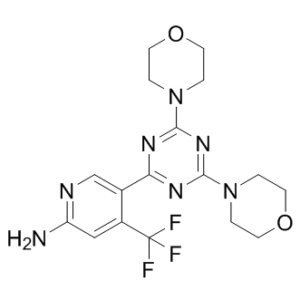This product is for research use only, not for human use. We do not sell to patients.

| Size | Price | Stock |
|---|---|---|
| 250mg | $1020 | Check With Us |
| 500mg | $1650 | Check With Us |
| 1g | $2475 | Check With Us |
Cat #: V2864 CAS #: 1225037-39-7 Purity ≥ 98%
Description: Bimiralisib (also known as PQR-309; PI3K-IN-2) is an orally bioavailable, brain-penetrant, and balanced pan-inhibitor of PI3K/mTOR (phosphoinositide-3-kinase/mammalian target of rapamycin) with IC50s of 33 nM, 451 nM, 661 nM, 708 nM and 89 nM for PI3Kα, PI3Kδ, PI3Kβ, PI3Kγ and mTOR, respectively.
Publications Citing InvivoChem Products
Product Promise

- Physicochemical and Storage Information
- Protocol
- Related Biological Data
- Stock Solution Preparation
- Quality Control Documentation
| Molecular Weight (MW) | 411.38 |
|---|---|
| Molecular Formula | C17H20F3N7O2 |
| CAS No. | 1225037-39-7 |
| Storage | -20℃ for 3 years in powder formr |
| -80℃ for 2 years in solvent | |
| Solubility In Vitro | DMSO: 10 mM in DMSOr |
| Water: N/Ar | |
| Ethanol: N/A | |
| SMILES Code | NC1=NC=C(C2=NC(N3CCOCC3)=NC(N4CCOCC4)=N2)C(C(F)(F)F)=C1 |
| Synonyms | Bimiralisib; PQR309; PQR-309; PQR309; PI3K-IN-2; PI3K IN-2 |
| Protocol | In Vitro | Bimiralisib is a highly selective pan-PI3K inhibitor with a balanced targeting of mTOR kinase. Bimiralisib also inhibits PI3Kα-H1047R), PI3Kα-E542K and PI3Kα-E545K with IC50s of 36 nM, 63 nM and 136 nM, respectively. |
|---|---|---|
| In Vivo | Oral administration yields similar concentrations of Bimiralisib in brain and plasma samples illustrates that Bimiralisib readily passes the blood–brain barrier. In mice, both po and iv application routes show a rapid drop below 200 ng/mL (~0.5 μM) of PQR309 within <1 h (iv) to <2 h (po) after administration, which reflects the time point when the drug reaches the median GI50 determined in tumor cell lines. In female rats a single oral dose (10 mg/kg) achieves similar drug levels as a single intravenous injection (5 mg/kg) with regard to Cmax. The half-life of 5-8 h and an AUC0.25-12 of around 14 000 h•ng/mL contributed to an excellent oral bioavailability of PQR309 (>50%). Twenty-four hours after po administration, plasma levels of PQR309 are still >2 μM (800-1000 ng/mL). Moreover, after 1-2 h exposure to PQR309 , drug levels in rat brain samples are comparable to plasma levels, confirming rapid access of PQR309 to the brain. |
| Solvent volume to be added | Mass (the weight of a compound) | |||
|---|---|---|---|---|
| Mother liquor concentration | 1mg | 5mg | 10mg | 20mg |
| 1mM | 2.4308 mL | 12.1542 mL | 24.3084 mL | 48.6169 mL |
| 5mM | 0.4862 mL | 2.4308 mL | 4.8617 mL | 9.7234 mL |
| 10mM | 0.2431 mL | 1.2154 mL | 2.4308 mL | 4.8617 mL |
| 20mM | 0.1215 mL | 0.6077 mL | 1.2154 mL | 2.4308 mL |
This equation is commonly abbreviated as: C1 V1 = C2 V2
- (1) Please be sure that the solution is clear before the addition of next solvent. Dissolution methods like vortex, ultrasound or warming and heat may be used to aid dissolving.
- (2) Be sure to add the solvent(s) in order.




































